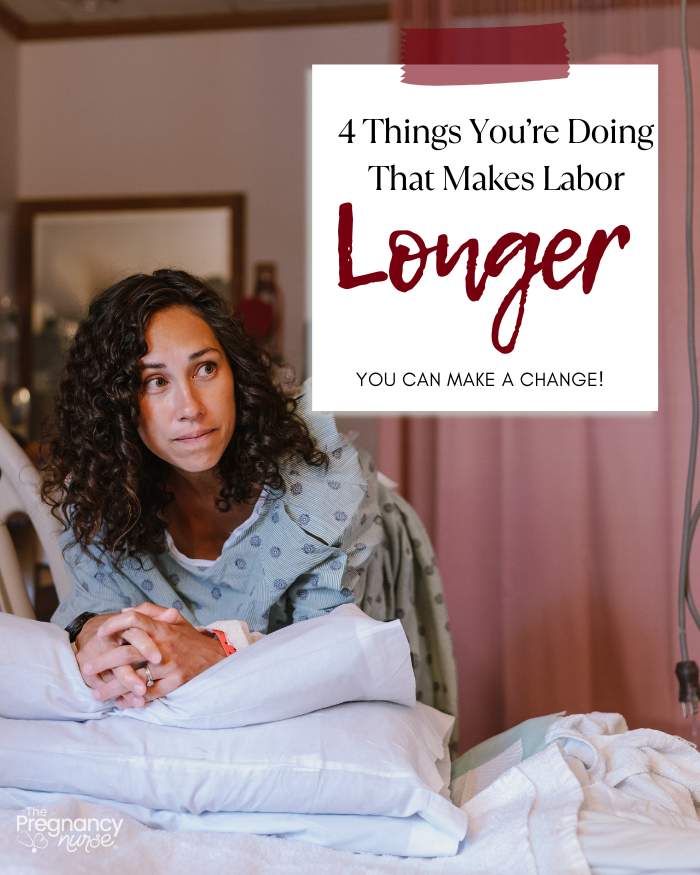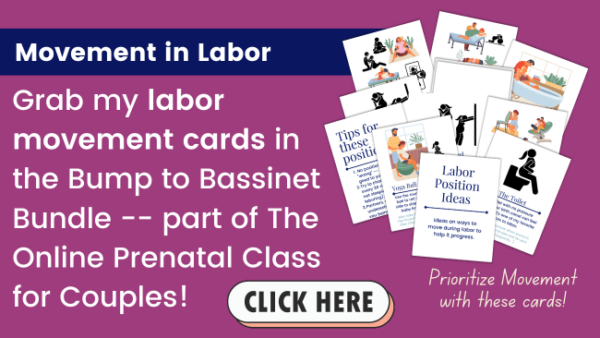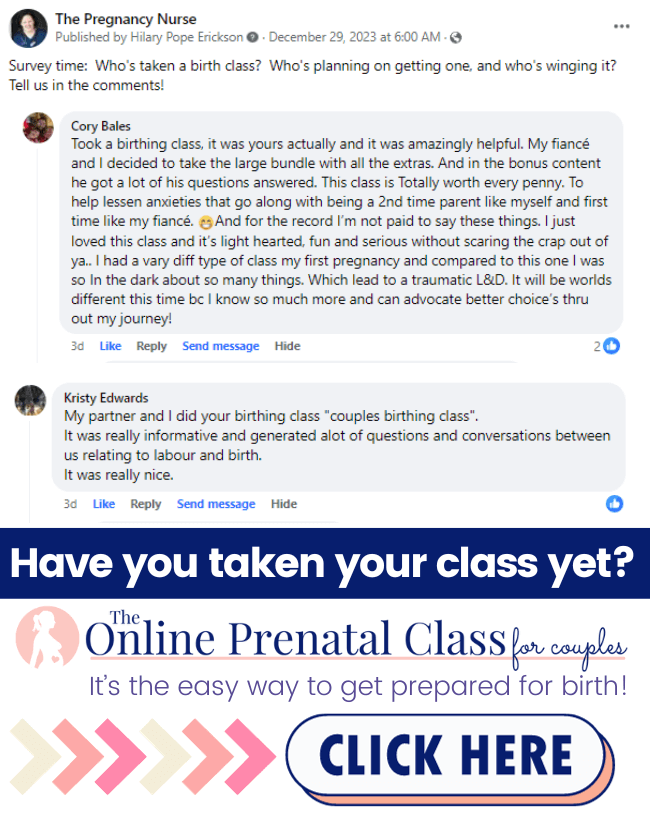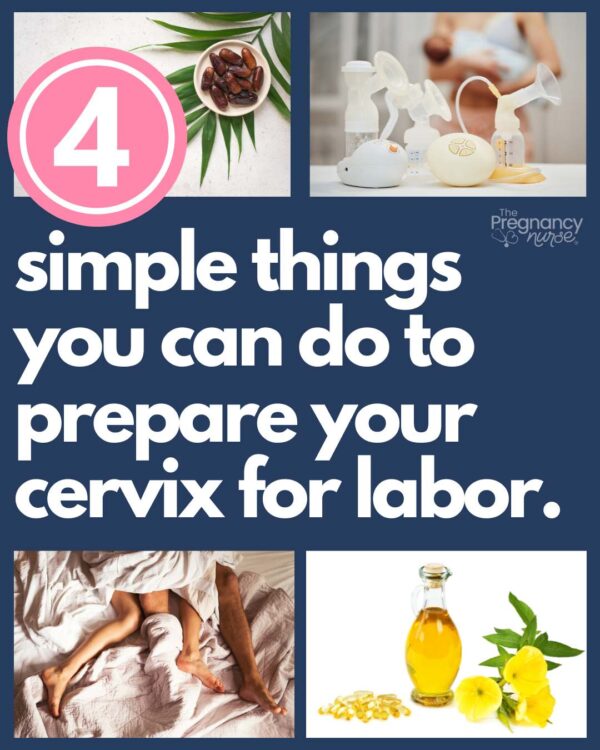Today I want to talk about a few things that you’re doing that makes labor longer than it has to be. Most of these have some pretty serious studies behind them, so it’s not just “The Pregnancy Nurse® THINKS it’s this way” — but truly evidence-based ways to make your labor faster. I’m excited to share them with you.

Before we get started, if you’re in your third trimester you do NOT want to miss my printable pack just for you:
I also have a video with tips like this in case you’re interested:
Ok, let’s get onto those mistakes:
Not Using Movement to Your Advantage
Now, this is a big one — and it comes in two parts:
- Movement BEFORE you go into labor
- Movement AFTER you’re in labor
Let’s discuss each of those:
Movement Before Labor
This is going to be things like deep squats & full range of movement exercise.
So many of us have sedentary jobs that require us in a chair staring at a keyboard, and all that sitting changes our pelvis — and not in a way that allows for the best movement of a baby into the birth canal.
I’m a HUGE fan of learning how to do deep squats, as well as performing squats during pregnancy.
Also, don’t forget lateral movement too!
If you have pelvic pain I would 100% recommend touching base with a physical therapist to make sure you’re doing squats safely for any pelvic issues you’re experiencing. I think I may have made my SPD worse by the squats I did with my 3rd.
There are SO many great prenatal workouts you can do on YouTube, I recommend you try a variety and see what works for you.
Lamaze has always incorporated a deep squat along with some breathing that helps to relax your pelvic floor and I think that’s smart!
You may also find that it helps your hips relax (which may lead to better sleep)!
Movement During Labor
Often our first response when we have pain is to curl-up in a ball and do nothing, but that’s not your best tactic in labor.
When you’re not doing the NEXT tip (stay tuned) I 100% recommend you move. These movements don’t have to be big if that makes you miserable, even just turning sides or propping your legs up on a few pillows can sometimes help baby shift into their best spot to come down the birth canal.
I know a lot of people swear by curb walking, but that can be really painful — I’m talking about just changes in position or how you’re resting.
During early labor — when you’re at home — you’re going to have to figure out some positions that can give baby this room. This has some helpful labor movement cards I think you’re going to love!
It’s just sometimes hard to come-up with ideas like this “on the fly” when you’re not feeling your best. SO, having cards like this, and discussing it with your partner in advance can help a lot!
Once you’re in labor at the hospital, let your nurse know that you’re up to move more. Your partner can offer to help them move you (especially great if you have an epidural) to make it easier on them. And, make sure you’re a willing participant — moving yourself as much as you can (that helps too).
Too many of us “sleep” on movement in labor — and it’s NOT doing us any favors. Be pro-active and it will help a lot!
Want to know more about movement — check out these posts:
- 3 Tips to Using Movement During Labor WITH an Epidural
- YOUR Birth Priorities: How to make them clear
- Your Third Trimester Checklist
Not Using Sleep
This one is especially true in early labor.
Sometimes our brains just turn crazy as we start to think “this is the REAL deal” and spend a lot of time timing contractions, when we might actually be able to sleep — and that could be a HUGE advantage.
If you’re past 37 weeks I usually recommend you ignore contractions until they’re closer than 7 minutes apart — the more you can ignore them for a while, the better off people seem to be. There’s a LOT in early labor in here — that is SO helpful (that can feel so lonely)!
I often recommend putting in some calming music, using a heating pad on anywhere that hurts (but not directly over your belly) and trying to rest as much as you can.
Of course, when you’re not ACTUALLY asleep, I think it’s smart to move every 30 minutes or so. A good partner can just check in with you every 30 minutes and if you’re not asleep, they can help you get into a good new position.
In the hospital I am actually a fan of asking for a sleeping pill if you’re having an extended induction and are able to sleep in early labor.
So many people are SO tired by the time baby actually comes, they are in a huge sleep deficit that isn’t doing them any favors — so prioritizing sleep is important!
SO important to get your partner on board with this one — taking a class with them can help a LOT for things like this, and many other important parts!
Not Preparing Your Cervix
Did you know that there are things you can do to prepare your cervix for labor?
Everyone seems to be looking for the magical cure to “start” labor and while I haven’t really found anything for that (besides this — which has a LOT of risks and I don’t recommend) — but I HAVE found a few things that can help soften that cervix in advance.
I have a whole post on the 4 things that can help prepare your cervix for labor:
The cliff notes are:
Each of those full posts has studies that show how they can soften your cervix when done/used correctly in the last month of your pregnancy.
MOST of those I recommend starting around 36 weeks — but you can start them after that if you want to try — I always recommend talking with your provider about them in advance. I have a whole video about it too:
Not Preparing Your Mind
Did you know that people who take a birth class have:
- Reduced chances of a cesarean section
- Reduced needs for induction/augmentation (aka, they labor faster)
- Increased satisfaction with their birth
Read the full studies on birth classes here.
Also, I really think you can “stop” labor by feeling nervous about it. Feeling prepared can help that oxytocin flow!
The thing is, many people take a free class online and check a birth class “off their list” — but the reality is that most birth classes (especially the free ones) fall short of what you actually need to prepare you for labor.
Actually getting prepared for birth — which includes:
- Learning the basics of labor
- Learning how to make choices for yourself
- Learning common interventions (including cesareans, inductions and labor interventions)
- Learning how to take care of yourself AFTER baby (this is HUGE and so often skipped)
Is one of the smartest things you can do during your pregnancy.
Studies show it can make your labor go faster, along with just you loving the experience of birth more.
For a long time we were stuck with what the hospitals offered, but there are so many more options out there any more. I recommend The Online Prenatal Class for Couples.
I love that it’s virtual (no more meshing busy schedules to try to find a Tuesday that works), created by an expert (you need one), and cuts the fluff you do NOT need because we’re all busy people!
So, those are 4 things you can change starting today to make labor go faster!
Have any other tips people have given you? Tell me in the comments, so we can discuss them together!











 Is an Induction More Painful than “Regular Labor”
Is an Induction More Painful than “Regular Labor”
